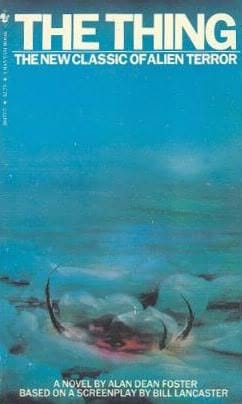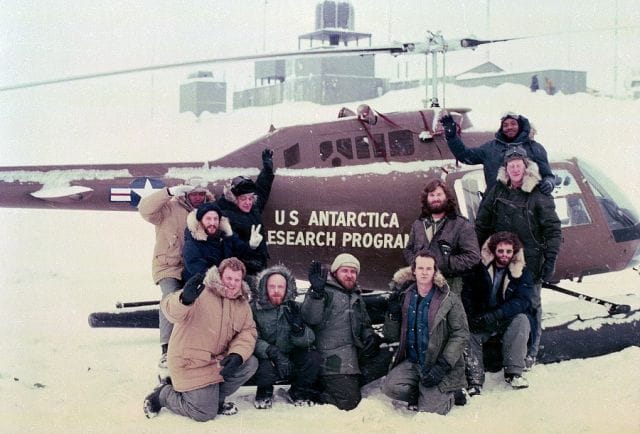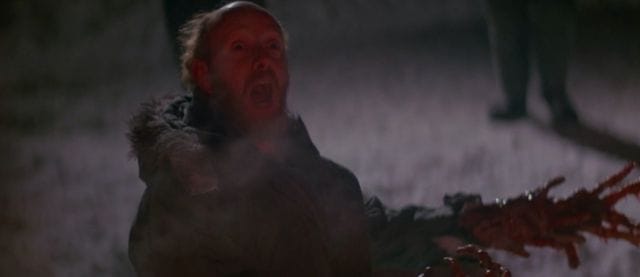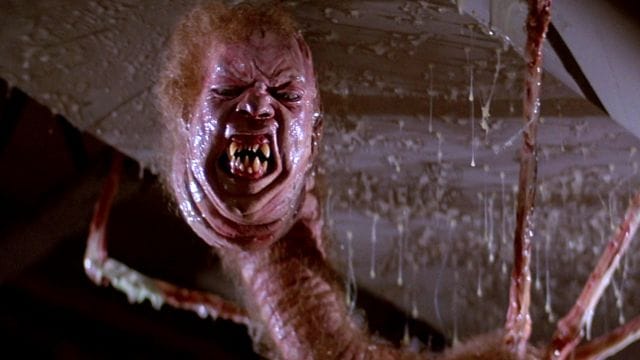Hollywood & Spine Archive: Here's 'The Thing'
An overview of the novelization to THE THING, originally published in January 2020.

I recently rewatched John Carpenter's The Thing at the Museum of Modern Art, part of a larger retrospective on the film's composer, Ennio Morricone. (Sadly, there was no real discussion of his score, which was replaced in parts by electronic pieces by Carpenter and Alan Howarth.) Anyway, rewatching it made me remember how much fun this novelization was. Alan Dean Foster is the GOAT of the craft for a reason, and his luck working on projects like this - with source material that significantly deviates in part from the final cut, thereby creating demand for fans - certainly doesn't hurt, either. You'll see a larger retrospective of Foster's work later on as the rest of the Hollywood & Spine archive migrates here. (Originally published 1/14/2020)

The Thing by Alan Dean Foster (based on the screenplay by Bill Lancaster and the story by John W. Campbell) (Bantam, 1982)
The pitch: John Carpenter directed this effects-heavy adaptation of the sci-fi novella about a shapeshifting alien at a research facility in Antarctica.
The author: One of the best-known novelization writers of all time, sci-fi author Alan Dean Foster's credits include devising the story for Star Trek: The Motion Picture and adaptations of multiple Alien films, two Star Wars films (including the original film, a novel credited to George Lucas) and Clash of the Titans. The Thing was his second adaptation of a John Carpenter film, following the director's 1974 debut Dark Star.
The lowdown: The Thing is a unique title, as it's a novelization of a film that itself is based on a piece of written fiction. (John W. Campbell's 1938 story Who Goes There? proved to be an influential piece of early 20th century short form sci-fi; in 2019, an earlier longer draft was published under the title Frozen Hell.)

Idea expansion is almost built into The Thing from the top down. Campbell's story first inspired 1951's loose adaptation The Thing From Another World, produced by Howard Hawks and featuring Gunsmoke's James Arness as a towering, plant-based hellion from the cosmos. Carpenter's The Thing was put into production after William F. Nolan, writer of Logan's Run, submitted his own unused treatment, closer in tone to Invasion of the Body Snatchers than the unbelievable creepy crawlers of the final film (designed by make-up wizard Rob Bottin). And, as we'll find, Foster manages to build upon Carpenter's new foundation, incorporating expansions of tone and executions of terror in a way that did not translate to the screen in exactly the same way (thanks in part to budgeting and what the actors brought to the finished film).
Foster went on record about his work on The Thing in an extended interview included on Shout! Factory's terrific Blu-ray edition of the film. In it, he revealed a fun piece of trivia: one of his first sci-fi stories was edited by none other than John W. Campbell, Jr., known perhaps more in that capacity than as a penman of prose. He also confirmed that his book, as most novelizations are, was based on an early draft of the screenplay - with no production photos to speak of. This, of course, leaves the film's creepiest monsters to the imagination - no severed heads on spider legs here.
Knowing what makes a novelization great, Foster avoided the temptation to incorporate anything more from Campbell's original source material in his book (save for a tongue-in-cheek moment when a spooked character utters the story's title). It's clear, then, that Lancaster's script did a great job of imbuing the story's 12 men in Antarctica with unique personalities. There are some things left unrealized in the final film: radio operator Windows is named Sanders here (and Sanchez in the original script, which explains his bilingualism in the book); Childs the mechanic grows the stash of marijuana in the base that he and Palmer are at one point seen enjoying. And MacReady, the heroic pilot played by Kurt Russell, isn't averse to goofing around the camp here, occasionally palling around with a blow-up doll!

It's worth noting, in fact, that Foster, using the script as a guide, went for a thread of gallows humor among the men of the base, undercutting the tension that translates to dark distrust in the final film. In the novelization, in fact, MacReady and Childs seem to have a rapport that frays as The Thing becomes increasingly present. (Late in the story, when former commander Garry demands to be untied from the couch after a blood test is conducted, the men laugh to break the tension.) There's no such respect in the final film, which ultimately makes the denouement that grittier.
Despite that shift, the book is as deft - maybe more so, in places - in balancing moments between characters with all the precision of a film editor. For a film with one general location for about three-quarters of its duration, the fluidity with which Foster zeroes in on the characters in and around Outpost 31 is delightful.
The cutting room floor: Lancaster's script, and ultimately Foster's book, allows fans of The Thing to consider a slightly more action-packed second half, garnished with suspense instead of fully propelled by it. About halfway through the story, it's discovered that more husky dogs were assimilated by The Thing than previously thought (recall, one of those dogs in the Norwegian camp was the carrier of the hostile alien) - and worse, they've escaped. What follows is a rousing chase on snowmobiles(!) with MacReady, Childs and meteorologist Bennings, killed during the chase instead of assimilated as in the final film. A different fate also awaits assistant biologist Fuchs - burned under mysterious circumstances in the movie, the book finds him disappearing when a generator blows at the base (it's heavily implied to be the work of stir-crazy-and-possibly-infected Blair), only to be later discovered impaled by an axe in Child's makeshift greenhouse. (This scene was shot, included in the Blu-ray as a still that's misidentified as a jump scare at the Norwegian base earlier in the film.)

When Norris is famously exposed as The Thing after a heart attack, a considerable change happens when Dr. Copper (or at least, his arms) avoids becoming the creature's lunch. He then assists MacReady in the suspenseful blood test scene, only to meet the same fate as Windows in the film when one of the crew is exposed as an impostor. The final battle with the infected Blair is also much more action-packed: the by-now exposed creature makes short work of Sanders and Garry with its sharp tentacles. (Poor Nauls, the cook, kills himself before the beast can infect him, a marked departure from his ambiguous disappearance in the final film.) MacReady's eventual victory is different, too, waged with a snowplow as battering ram before finishing the creature off with explosives. It would've made for a very different movie, and as fun as it is to read this way, it's fair that Carpenter's way was the right choice. (For more on some of these cut scenes, and a whole lot of great stuff, The Thing fan site Outpost 31 is a must.)

The last word: With plenty of great detail expanded from the source material (both the short story and the final film), Foster's book is one Thing you won't want to miss. It can be a hot commodity on the secondary market, but well worth it.
